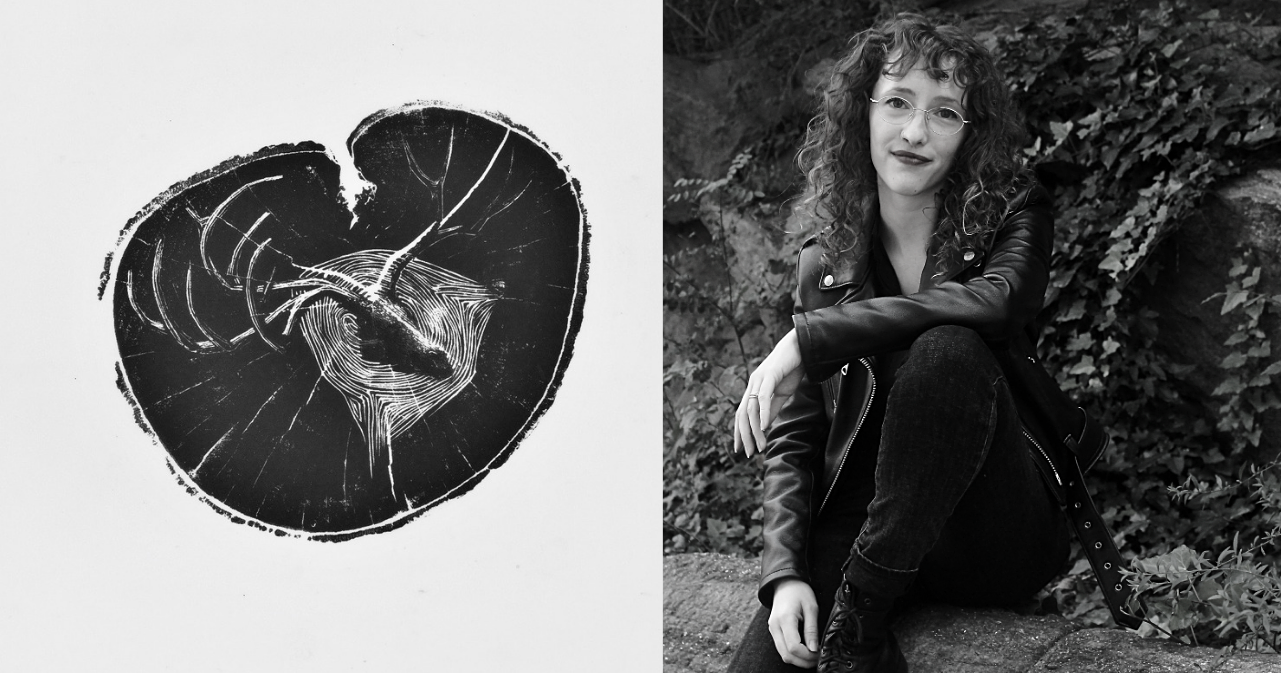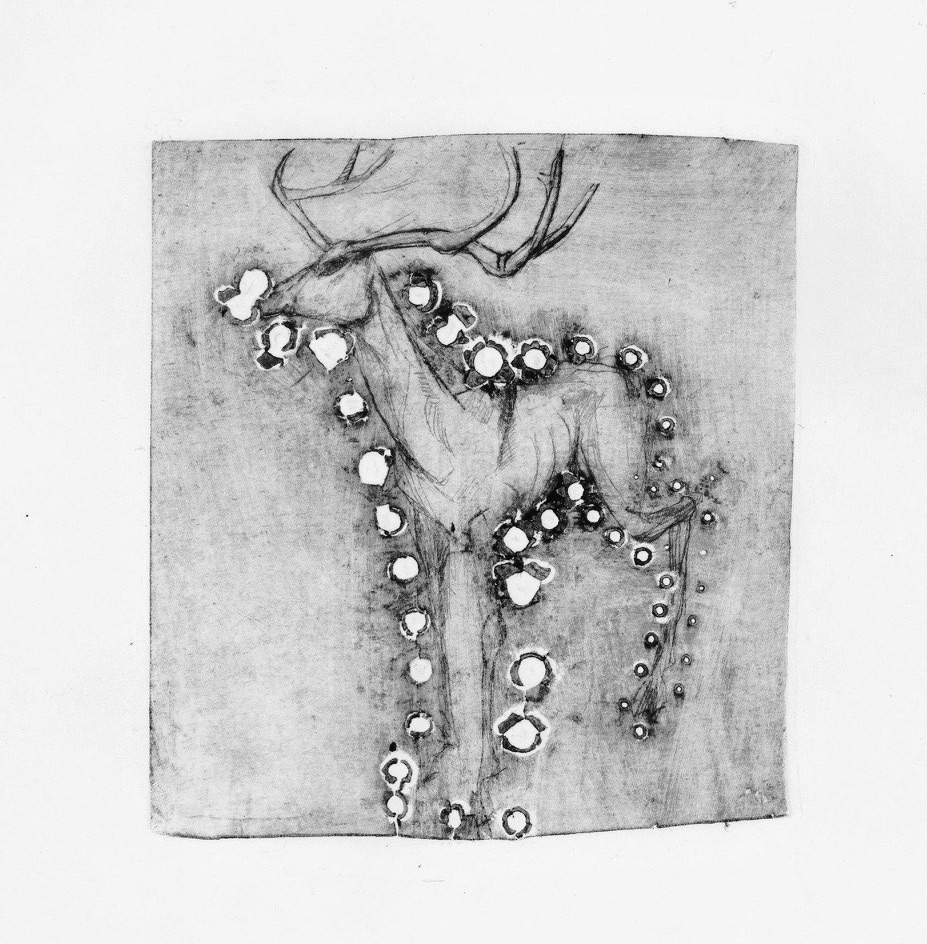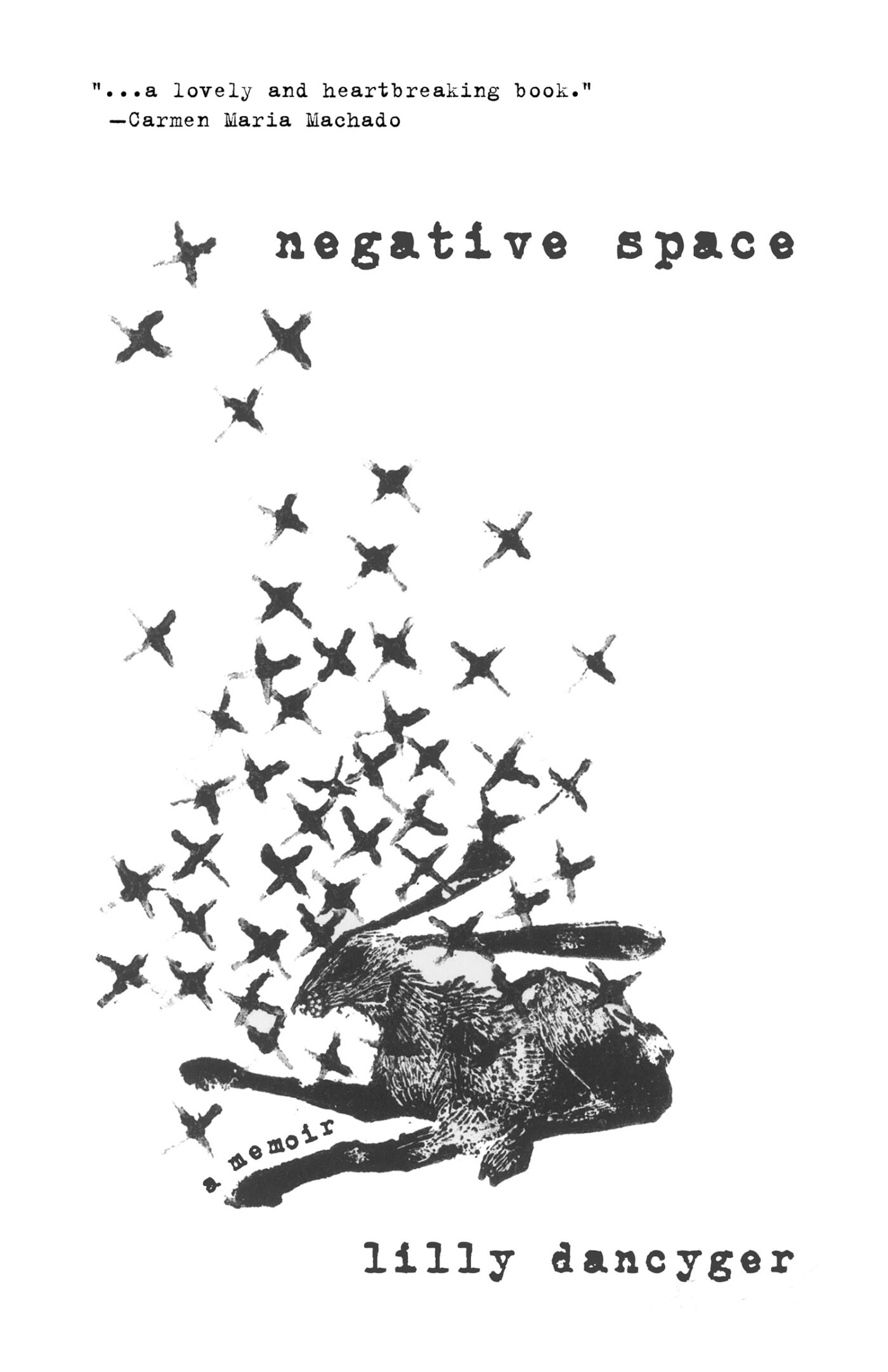*Interviews — May 4, 2021
Lilly Dancyger on Negative Space

Lilly Dancyger beside a piece by her father, Joe Schactman, woodcut on paper. Both images courtesy of Lilly Dancyger.
{
}
.firstcharacter {
float: left;
font-size: 100px;
line-height: 60px;
padding-top: 4px;
padding-right: 8px;
padding-left: 3px;
padding-bottom: 0px;
margin-bottom: 0px;
}
As a child, Lilly Dancyger lived in an art-saturated world. Her father, Joe Schactman, was a vital part of the East Village alternative art scene in the 1980s. His work included a vast array of visual art and sculpture, often using found and natural objects. Schactman passed away when Dancyger was eleven. In her debut memoir, Negative Space, Dancyger uses her art – writing – to communicate with his, images of which appear in the book’s pages. In so doing, she vividly renders a journey of coming to terms with grief, addiction, inherited trauma and memory, coming of age, New York, and the meaning of family. Integrating interviews with Schactman’s friends, her own lived experiences, and deep engagement with her father’s work, Dancyger creates an expansive and profoundly moving story that ultimately embodies a kind of infinite imperfect love – which, really, is the only kind. I talked with Lilly over the phone about archives, memory, chosen family, and how relationships continue to evolve after death.

LD
SARAH NEILSON: Was there anything you discovered about the process of working deeply with archival material that surprised you? What was that process like for you?
LILLY DANCYGER: I’ve lived surrounded by my father’s artwork for my entire life. It’s part of the atmosphere of my life and has been since childhood, and I’ve always loved it. If there’s ever a fire in my apartment, the artwork is what I would grab. They’ve been my most important and beloved possessions, but it was still an entirely different kind of experience to engage with the artwork so directly and actively, really start to ask it questions, start to try to put the work into a timeline, try to understand the evolution of style and ethos and symbolism over time. To connect the dots between the pieces and start to see the archive as one massive entity instead of the individual pieces that I love. Sitting in my living room right now, I can see 10 pieces of his artwork from where I’m sitting. It’s like if you’ve known somebody for a long time and the first time you have a really serious deep conversation with them it feels like your relationship has moved on to a different level. It felt like that.
SN: This book, which is a work of art you made, is in direct communication with your dad’s work. In what ways was writing this book an important way not just to manifest grief into an object, but to provide context for your own story and the stories that you tell in it?
LD: I like that you call it a conversation, I thought of it that way, too. I came to think of it as a collaboration or a call and response across mediums. A lot of what I’m engaging with here is learning to see my parents as people and as individuals who have their own lives outside of their obligation to me and their relationship to me. And learning that the person for whom I’ve grieved most deeply also experienced grief. Now, it’s this act of widening the lens and decentralizing of myself, and remembering that my own perspective on my life and the experiences of the people I’m writing about is not the only perspective. My father had this whole life before me and he experienced grief and love and all kinds of things I would later experience.
SN: The parallels between your father’s experiences and yours also included a profound experience of chosen family. What was it like for you to not only discover but explore that parallel?
LD: The idea of chosen family is something that’s really important to me. The close friends that I had as a teenager are absolutely my family—I say all the time: we raised each other. As I wrote in the book, I had an unstable home life and I found these other kids who did, too; we provided that security and support and love and protection for each other that we weren’t provided otherwise. It’s only later that I realized my parents had modeled for me the idea that your friends can be your family, because they both had people like that. My father had a lot of friends. He was widely beloved by a lot of people. Something I discovered in the process of writing this book was how many people really loved him deeply. I knew that he really cherished his friends because they were always around, they were treated like family. And my mother, too. My godmother who we stayed with when we moved back to New York was my mom’s best friend since she was nine years old, and she’s still in my life. She bought me my wedding shoes, you know?
SN: In the beginning of the narrative, you were positioned in this mindset of resistance, resistance to growing up, and what you felt was leaving your father behind or becoming someone he wouldn’t know. The book has this arc that takes you to a point where you realize your relationship with him doesn’t have to be defined by that, it can continue. Can you talk about how that arc came to be, and how much the actual process of writing the book had to do with that transformation in yourself, if it did?
LD: [I realized] that grief didn’t have to be the only way for me to stay connected to my father. It was a years-long process of coming to understand that, and I think I started to understand it intuitively a lot earlier than I was able to actually articulate it. I wasn’t really consciously aware of it or able to put it into words until I was working on the book. I’m trying to articulate this feeling of knowing that my relationship to him and my relationship to grief was changing and growing, and knowing that that process was uncomfortable and scary, but also necessary and fulfilling. When you’re in the middle of something like that, you can’t see it clearly. But looking back, I understood that it was finding a way to connect to him other than being shrouded in grief and letting grief be the defining characteristic of who I am. And holding on to that teenage angst… eventually, you have to let it go. As much as I tried to hold on to it, it became inauthentic; I had to acknowledge that I was not that person anymore. And if I’m not that person anymore, then how does grief fit into my life? That was the inciting question that drove me to start writing this book; I was looking for a new way to live with grief and to live with my father’s memory.
SN: Speaking of memory, one of my favorite paragraphs in the book is when you describe your father hitchhiking: “I think he felt then: a desire for nature, fate, chance, challenge, triumph. An escape from the mundane and into the truth of being a human animal, trying to stay alive and creating a path as you’re on it, through improvisation and ingenuity… I like to imagine my father’s travels, thinking that they’re in my DNA and that maybe what I felt back then wasn’t desire, but memory.” How do you experience inherited memory?
LD: That’s another thing I didn’t really start to understand until I was writing the book. I’ve always known I am a lot like my father because everybody has told me that my whole life – his friends and my mother, sometimes in a positive way, sometimes not. My mom used to say it when we were fighting, when I was a teenager, and I never understood why it was an insult. But later I got to understand what she meant… She was calling me a stubborn, selfish jackass. And yeah, I was; I was a teenager.
So I knew I was a lot like my father, but there are levels and degrees to which I’m like him that I didn’t really understand until I was writing about him and really wrapped my head around the intricacies of how he saw the world, and seeing so much of that in myself. I realized how much of his perspective, his way of viewing art and people and what it means to be an artist, and to live in the world with specific values, all of that that I absorbed – some of it through his direct instruction but also through osmosis, maybe inheritance. Like the desire for the feeling I imagine getting from hitchhiking, which I craved—how is that passed down? There is some science behind the idea of memory imprinted in your DNA. Genetically inherited trauma is studied. But if trauma is imprinted and passed down, I would imagine other things are too.
SN: One of the techniques that you use in the memoir is to reconstruct and speculate memories into existence. As a reader, that feels really crucial to the narrative and it doesn’t matter if they’re “accurate” or not because they’re still real. Can you describe your approach to doing that and why it felt so integral to your process of writing a book?
LD: I did so much research. I spent years and years really trying to reconstruct as much of the story as I could, and get as full and detailed and accurate a picture of my father’s life as possible. But still, there were gaps. There always was going to be a distance between what I was able to put together and the actual reality of being there. There are some things that nobody else was there for. It’s impossible for me to actually know what those moments were like. There’s no amount of research I can do that will tell me what the moment was like when he walked out the door and left [his first love], Cathy, who is also dead. And so all I could do was imagine it. But some of those moments are so pivotal. They’re very important moments in the story. From a craft perspective, readers want to see the important pivotal emotional moments, and so I made the decision to just give myself permission to imagine them and trust that I had done enough research and I had spent enough time with this story that I could make an educated guess. In some moments it could have gone a few different ways; I let the readers decide which way they think it went, because I don’t know for sure.
SN: I want to touch on the ideas of fear and vulnerability. You have this great line that reads, “I felt much less vulnerable as a writer doing research than as a grieving girl, searching for scraps of her father.” How do you decide how vulnerable to be in your art, or is it even always a choice?
LD: The parts of the story that scared me, that’s the good stuff. The spots that felt tender, the parts you might be hesitant to approach. If you can articulate those feelings, well, those are the moments that connect me with people, because chances are that the things that scare me have also scared someone else. It’s my job as the person writing this story to find a way to look directly at those scary things and articulate them. I know as a reader, those are the moments that make me fall in love with a book. It’s when I see something articulated that I have also felt but that I was unable or afraid to articulate or see clearly. So, when I felt that as a writer, I knew that I was getting warmer, closer to the real heart of the story. I didn’t push myself into it right away, though. I did a lot of circling around and circling back, and sometimes I would know that there was something I was going to have to address eventually, but I wasn’t ready yet so I would leave it for later. That’s one benefit of spending a decade writing a book; you don’t have to do the hard stuff right away; you can come back to it as you’re ready. And there is always going to be more hard stuff later.
SN: How are you caring for yourself right now as you promote this book that’s so much about grief?
LD: Not much right now, but I’m planning some major downtime and rest and recuperation after all this is over. What’s weird is, I spent so long on the book that a lot of the subject matter—even though it is very tender and personal—has been transmuted already, it exists separately. This book is an artwork that is made out of experiences but it’s not those experiences. So, people having access to the book is not exactly the same as people having access to my inner self. To a degree, it is very exposing, and it’s uncomfortable, I won’t deny it, but it’s more the general feeling of being exposed than it is bringing up the specifics of the grief and my childhood.
SN: Are there any parts of the book where you feel like the communication between the language of your art and the language of your father’s art is especially potent?
LD: Yeah, the Hunter/Hunted section. The Hunter/Hunted was a series that my father did of prints and sculptures of deer. A lot of them had human hands for antlers. The series is all about the cyclical nature of pursuit, and pursuit and pursuer being the same entity, and I had this realization that that’s also what I was doing – pursuing him to write a book about him that, along the way, also became a memoir.

* * *
Lilly Dancyger is the author of Negative Space, a reported and illustrated memoir selected by Carmen Maria Machado as a winner of the Santa Fe Writers Project Literary Awards; and the editor of Burn It Down, an anthology of essays on women’s anger. Find her on Twitter at @lillydancyger.
Sarah Neilson is a freelance writer. They can be found on Twitter @sarahmariewrote.
Originally published in No Tokens Issue No. 9. View full issue & more.
Images: Etching, drawing, and burned holes on paper, Joe Schactman, courtesy of the author Lilly Dancyger